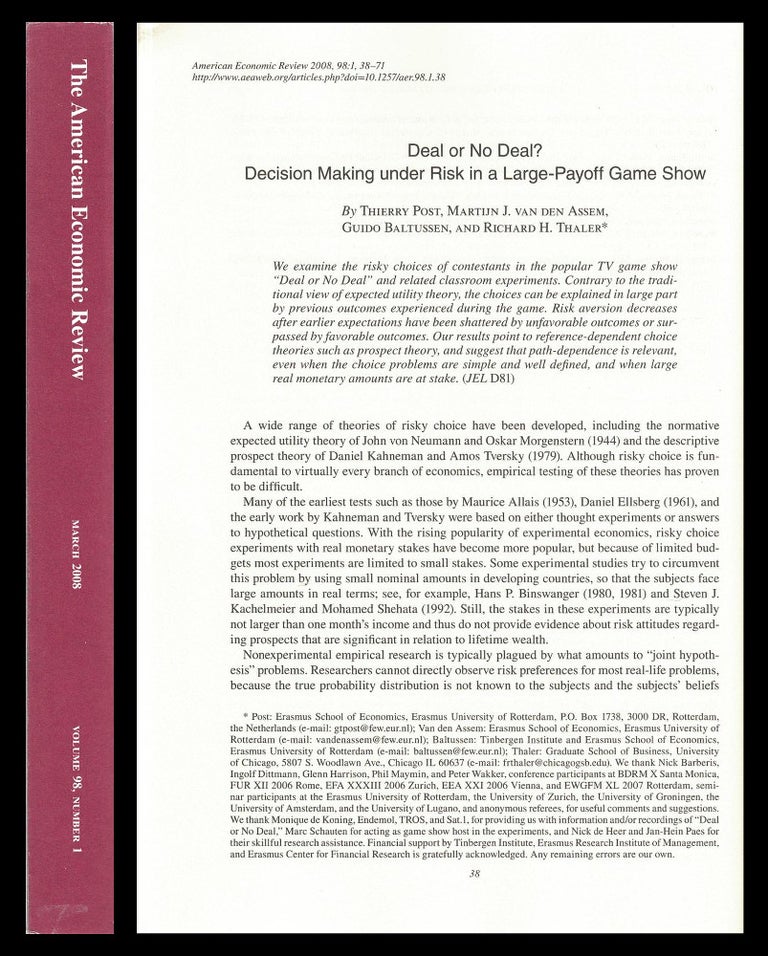Deal or No Deal? Decision Making under Risk in a Large-Payoff Game Show in The American Economic Review 98 No. 1 pp. 38-71, March 2008
Washington DC: American Economic Association, 2008. 1st Edition. FIRST EDITION IN ORIGINAL PRINTED WRAPS OF A 2008 PAPER ON BEHAVIORAL ECONOMICS CO-WRITTEN BY THE 2017 NOBEL PRIZE WINNER IN ECONOMICS, RICHARD THALER. A team of economists — Post, Van den Assem, Baltussen & Thaler — “analyzed the decisions of people appearing on Deal or No Deal and found, among other things, that contestants are less risk averse when they have seen their expected winnings tumble. "Losers" tend to continue playing the game even if this means rejecting bank offers in excess of the average of the remaining prizes” (Wikibooks). “Thaler has had a long body of work contributing to our understanding of Economics and business and consumer decision making” and this paper is noted in the Nobel Committee’s ‘advanced information’. Note that we offer two other Richard Thaler papers separately, "Save More Tomorrow" in Journal of Political Economy 112, 1, 2, February 2004 and "Libertarian Paternalism" in The American Economic Review 93, No. 2, pp. 175-179, May 2003.
Thaler’s work, including that put forth in this paper, has been devoted to integrating economics with psychology. Thaler “has incorporated psychologically realistic assumptions into analyses of economic decision-making. By exploring the consequences of limited rationality, social preferences, and lack of self-control, he has shown how these human traits systematically affect individual decisions as well as market outcomes” (Nobel Prize Committee).
The authors “started with field data from the ‘Deal or No Deal’ television show [running in three countries]. After making many simplifying assumptions, they could infer risky choice preference parameters from the contestants’ decisions. The central interesting feature of their analysis is that decisions are consistent with risk tastes depending on prior outcomes in a sequence of choices. Specifically, contestants exhibit a ‘break-even effect’ (taking risks to reach a previous point of reference) and a ‘house money’ effect (taking more risks when the set of possible winning amounts shifts upward). They also conducted parallel lab experiments which had many features of the TV game show, including a grinning ‘game show host’, a live audience, video cameras, a computerized display of unopened briefcases, remaining prizes, and ‘bank offers’. They report that ‘the audience was very excited and enthusiastic during the experiment, applauding and shouting hints, and most contestants showed clear symptoms of distress’” (Fréchette, Handbook of Experimental Economic Methodology).
The authors concluded that “Choices in the experiment are remarkably similar to those in the original TV show, despite the fact that the experimental stakes are only a small fraction of the original stakes. Consistent with the TV version, the break-even effect and the house-money effect also emerge in the experiments” (ibid; Post et al., 2008, p. 68). Item #1067
CONDITION & DETAILS: Washington, D. C.: American Economic Association. Light ex-libris stamp on the from wrap. 4to. 562 pages. Very slight edge wear. Bright and very clean inside and out. Near fine.
Price: $160.00

